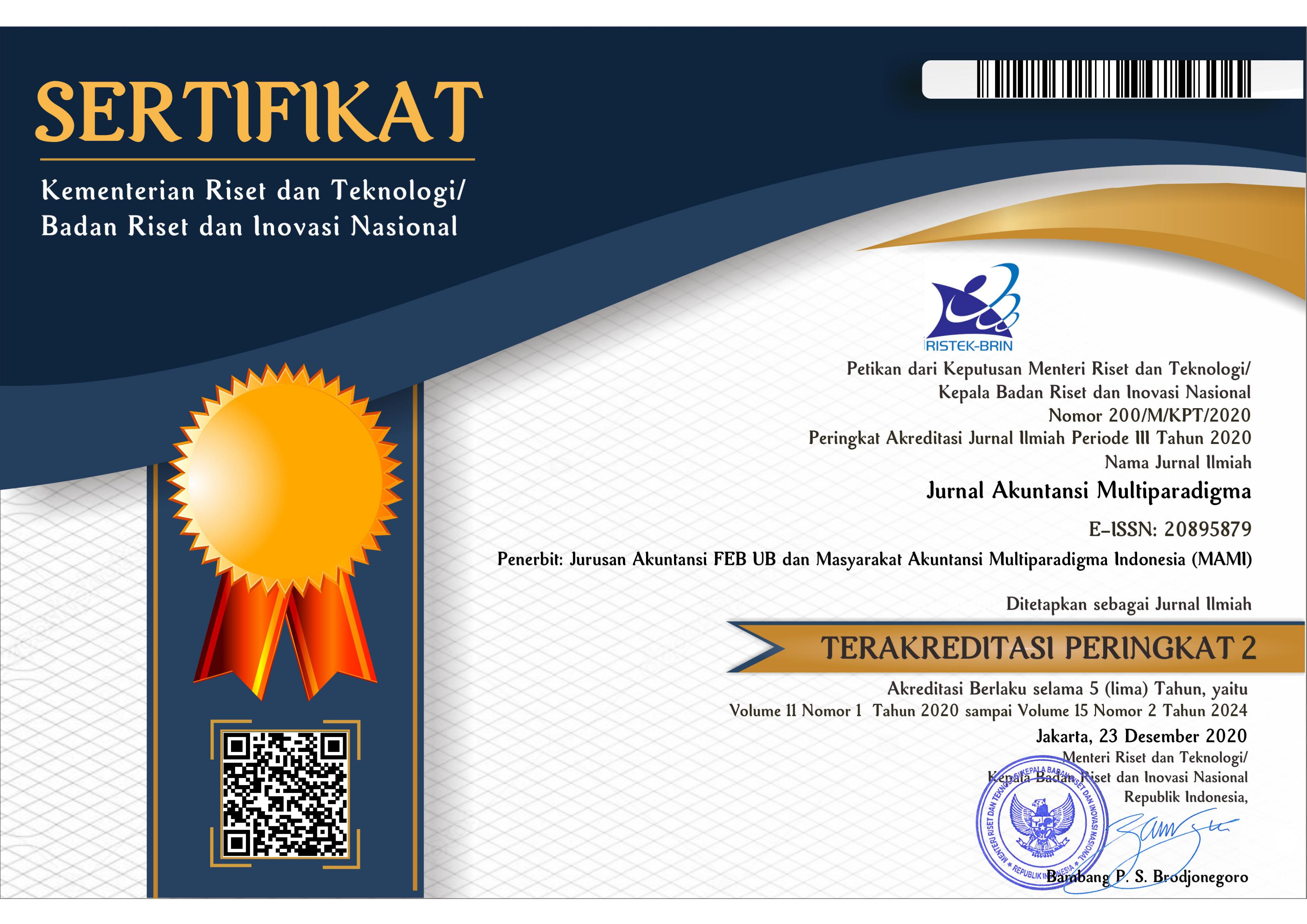DILEMA PENERIMAAN TIME VALUE OF MONEY DALAM PRAKTIK AKUNTANSI SYARIAH
Abstract
Abstrak – Dilema Penerimaan Time Value of Money dalam Praktik Akuntansi Syariah
Tujuan Utama - Penelitian ini berupaya untuk mengeksplorasi makna time value of money (TVM) dalam praktik akuntansi syariah.
Metode – Fenomenologi transendental dan ekstensi dengan ayat Alquran digunakan sebagai metodologi. Data diperoleh melalui hasil wawancara mendalam terhadap informan praktisi bank syariah dan pakar akuntansi syariah.
Temuan Utama – Penelitian ini menemukan bahwa TVM dimaknai sebagai konsep dan teknis yang tidak diatur dalam rukun murabahah dan bukan merupakan transaksi. Meskipun terdapat beberapa unsur di dalamnya yang bertentangan dengan nilai dalam Alquran, konsep TVM tidak dapat dihukumi haram atau halal. Anuitas juga diyakini lebih mashlahah.
Implikasi Teori dan Kebijakan – Penelitian ini memberikan implikasi bahwa konsep TVM sudah tidak perlu diperdebatkan. Selain itu, kerangka akuntansi syariah dapat menerima konsep TVM dan menggunakan formula anuitasnya asalkan tidak merusak substansi dari transaksinya.
Kebaruan Penelitian – Penelitian memberikan detil penjelasan bagaimana anuitas-TVM dapat dipraktikkan pada akuntansi syariah.
Abstract - Dilemma of Acceptance of Time Value of Money in Shariah Accounting Practices
Main Purpose - This study explores the meaning of the time value of money (TVM) in shariah accounting practices.
Method - Transcendental phenomenology and extension with the verses of the Qur'an are used as methods. Shariah bank practitioners and sharia accounting experts are the informants.
Main Findings - This study finds that TVM is interpreted as a concept and a technique that is not regulated in “murabahah” pillar. Even though there are contradictions in the values in the Qur'an, the TVM concept can not be labeled haram or halal. Annuities are also believed to be more “mashlahah”.
Theory and Practical Implications - This study implies that the concept of TVM does not need to be debated. In addition, the shariah accounting framework can accept the TVM concept as long as it does not damage the substance of the transaction.
Novelty - This study provides a detailed explanation of how the TVM-annuity can be practiced in shariah accounting.
Keywords
Full Text:
PDFReferences
Abdullah, A. (2016). An Islamic Monetary Theory of Value and Equation of Exchange: Evidence from Egypt (696-1517). Humanomics, 32(2), 121-150. https://doi.org/10.1108/H-12-2015-0090
Ahmed, M. U., Sabirzyanov, R., & Rosman, R. (2016). A Critique on Accounting for Murabaha Contract: A Comparative Analysis of IFRS and AAOIFI Accounting Standards. Journal of Islamic Accounting and Business Research, 7(3), 190-201. https://doi.org/10.1108/JIABR-04-2016-0041
Al-Hares, O. M., AbuGhazaleh, N. M., & El-Galfy, A. M. (2013). Financial Performance and Compliance with Basel III Capital Standards: Conventional vs. Islamic Banks. Journal of Applied Business Research, 29(4), 1031-1048. https://doi.org/10.19030/jabr.v29i4.7914
Al-Fijawi, M. F. A., & Yunus, S. M. (2019). Modern Applications of Profit-Sale (Bayʿ Murābaḥah) from a Maqāṣid Sharīʿah Perspective. Al-Shajarah, 24(1), 49-66.
Amir, V. (2014). “Menggiring” Economic Value of Time Menjadi Time Value of Money (Telaah Kritis Penggunaan Anuitas). Imanensi: Jurnal Ekonomi, Manajemen, dan Akuntansi Islam, 1(2), 97-102. https://doi.org/10.34202/imanensi.1.2.2014.97-102
Antonio, M. S., Laela, S. F., & Jazil, T. (2020). Abu Zahrah’s Maqasid Sharia Model as a Performance Measurement System. Jurnal Akuntansi Multiparadigma, 11(3), 519-541. https://doi.org/10.21776/ub.jamal.2020.11.3.30
Azoitei, D. C. (2020). Critical Analysis of the Contemporary Application of Riba in Islamic Banking. Manchester Journal of Transnational Islamic Law and Practice, 16(1), 76-94.
Baber, H. (2017). A Comparative Study of Islamic Housing Finance Models and Issues. Qualitative Research in Financial Markets, 9(2), 168-180. https://doi.org/10.1108/QRFM-12-2016-0053
Baehaqi, A., Birton, M. N. A., & Hudaefi, F. A. (2020). Time Value of Money in Islamic Accounting Practice: A Critical Analysis from Maqāṣid Al-Sharī‘ah. Journal of Islamic Accounting and Business Research, 11(9), 2035-2052. https://doi.org/10.1108/JIABR-09-2018-0155
Berglund, H. (2015). Between Cognition and Discourse: Phenomenology and the Study of Entrepreneurship. International Journal of Entrepreneurial Behavior & Research, 21(3), 472-488. https://doi.org/10.1108/IJEBR-12-2013-0210
Budd, J. M., & Velasquez, D. L. (2014). Phenomenology and Organizational Communication. New Library World, 115(7/8), 394-404. https://doi.org/10.1108/NLW-03-2014-0028
Chabrak, N., Haslam, J., & Oakes, H. (2019). What is Accounting? The “Being” and “Be-Ings” of the Accounting Phenomenon and Its Critical Appreciation. Accounting, Auditing & Accountability Journal, 32(5), 1414-1436. https://doi.org/10.1108/AAAJ-08-2017-3097
Choudhury, M. A. (2018). Micro-Money, Finance and Real Economy Interrelationship in the Framework of Islamic Ontology of Unity of Knowledge and the World-System of Social Economy. International Journal of Social Economics, 45(2), 445-462. https://doi.org/10.1108/IJSE-11-2016-0340
Dahlberg, H., & Dahlberg, K. (2020). Phenomenology of Science and the Art of Radical Questioning. Qualitative Inquiry, 26(7), 889–896. https://doi.org/10.1177/1077800419897702
Djalaluddin, A., & Mumpuni, D. (2020). Riba versus Sedekah sebagai Konsideran Tazkiyah Akuntansi dan Bisnis. Jurnal Akuntansi Multiparadigma, 11(3), 450-478. https://doi.org/10.21776/ub.jamal.2020.11.3.27
Elnahass, M., Omoteso, K., Salama, A., & Trinh, V. Q. (2020). Differential Market Valuations of Board Busyness Across Alternative Banking Models. Review of Quantitative Finance and Accounting, 55(1), 201-238. https://doi.org/10.1007/s11156-019-00841-4
Farooq, M. O. (2019). Rent-Seeking Behaviour and Ẓulm (Injustice/Exploitation) Beyond Ribā-Interest Equation. ISRA: International Journal of Islamic Finance, 11(1), 110-123. https://doi.org/10.1108/IJIF-07-2018-0073
Gharbi, L. (2016). A Critical Analysis of the Use of Fair Value by Islamic Financial Institutions. Journal of Islamic Accounting and Business Research, 7(2), 170-183. https://doi.org/10.1108/JIABR-10-2013-0037
Hamza, H., & Jedidia, K. B. (2017). Money Time Value and Time Preference in Islamic Perspective. Turkish Journal of Islamic Economics, 4(2), 19–35. https://doi.org/10.26414/tujise.2017.4.2.19-35
Hassan, M. K., Aliyu, S., Huda, M., & Rashid, M. (2019). A Survey on Islamic Finance and Accounting Standards. Borsa Istanbul Review, 19, 1-13. https://doi.org/10.1016/j.bir.2019.07.006
Hutchinson, M. C., Mulcahy, M., & O'Brien, J. (2018). What is the Cost of Faith? An Empirical Investigation of Islamic Purification. Pacific Basin Finance Journal, 52, 134-143. https://doi.org/10.1016/j.pacfin.2017.05.005
Hurwitz, A., & Sade, O. (2020). An Investigation of Time Preferences, Life Expectancy, and Annuity versus Lump Sum Choices: Can Smoking Harm Long-Term Saving Decisions? Journal of Economic Behavior and Organization, 180, 812-825. https://doi.org/10.1016/j.jebo.2019.05.011
Husserl, E. (1970). The Crisis of European Sciences and Transcendental Phenomenology: An Introduction to Phenomenological Philosophy. Northwestern University Press
Ibrahim, A. A., Elatrash, R. J., & Farooq, M. O. (2014). Hoarding versus Circulation of Wealth from the Perspective of Maqasid Al-Shari'ah. International Journal of Islamic and Middle Eastern Finance and Management, 7(1), 6-21. https://doi.org/10.1108/IMEFM-06-2012-0053
Istan, M., & Fahlevi, M. (2020). The Effect of External and Internal Factors on Financial Performance of Islamic Banking. Jurnal Ekonomi dan Studi Pembangunan, 21(1), 137–145. https://doi.org/10.18196/jesp.21.1.5036
Jackson, C., Vaughan, D. R., & Brown, L. (2018). Discovering Lived Experiences through Descriptive Phenomenology. International Journal of Contemporary Hospitality Management, 30(11), 3309-3325. https://doi.org/10.1108/IJCHM-10-2017-0707
Kamayanti, A. (2016). Metodologi Penelitian Kualitatif Akuntansi: Pengantar Religiositas Keilmuan. Yayasan Rumah Peneleh.
Kamla, R., & Alsoufi, R. (2015). Critical Muslim Intellectuals’ Discourse and the Issue of “Interest” (Ribā): Implications for Islamic Accounting and Banking. Accounting Forum, 39(2), 140–154. https://doi.org/10.1016/j.accfor.2015.02.002
Khir, M. F. A. (2016). Bilateral Rebate (Ibra’ Mutabadal) in Islamic Banking Operation: A Critical Appraisal. International Journal of Islamic and Middle Eastern Finance and Management, 9(3), 435-452. https://doi.org/10.1108/IMEFM-07-2015-0085
Khurram, S, Khurram, A, & Memon, M. A. (2019). Stakeholder Salience and Collaboration Decisions in Microfinance Organizations: Evidence from Developing Islamic Country's Context. Strategic Change: Briefings in Entrepreneurial Finance; 28(6), 479–497. https://doi.org/10.1002/jsc.2300
Mastrosimone, C. (2013). Introduction to the Practices and Institutions of Islamic Finance Between the Islamic World and the West. Journal of Global Policy and Governance, 2(1), 121–132. https://doi.org/10.1007/s40320-013-0025-4
Mulcahy, M. B. (2014). Purifying Islamic Equities: The Interest Tax Shield. International Journal of Islamic and Middle Eastern Finance and Management, 7(4), 473-484. https://doi.org/10.1108/IMEFM-11-2013-0120
Nurindrasari, D., Triyuwono, I., & Mulawarman, A. (2018). Konsep Pengukuran Kinerja Berbasis Kesejahteraan Islam. Jurnal Akuntansi Multiparadigma, 9(3), 394-416. https://doi.org/10.18202/jamal.2018.04.9024
Pokropski, M. (2019). Phenomenology and Mechanisms of Consciousness: Considering the Theoretical Integration of Phenomenology with a Mechanistic Framework. Theory & Psychology, 29(5), 601–619. https://doi.org/10.1177/0959354319868769
Priya, A. (2017). Phenomenological Social Research: Some Observations from the Field. Qualitative Research Journal, 17(4), 294-305. https://doi.org/10.1108/QRJ-08-2016-0047
Ranse, J., Arbon, P., Cusack, L., Shaban, R. Z., & Nicholls, D. (2020). Obtaining Individual Narratives and Moving to an Intersubjective Lived-Experience Description: A Way of Doing Phenomenology. Qualitative Research, 20(6), 945–959. https://doi.org/10.1177/1468794120905988
Riaz, U., Burton, B., & Monk, L. (2017). Perceptions on the Accessibility of Islamic Banking in the UK—Challenges, Opportunities and Divergence in Opinion. Accounting Forum, 41(4), 353-374. https://doi.org/10.1016/j.accfor.2017.10.002
Roberts, B. E. (2019). Husserl’s Epoche and the Way of the Sword: Exploring Pathways into Phenomenological Inquiry. Qualitative Research Journal, 19(4), 391-402. https://doi.org/10.1108/QRJ-02-2019-0022
Sadr, S.K . (2015). The Role of Human Capital in Economic Development of the Earliest Islamic Period. International Journal of Islamic and Middle Eastern Finance and Management, 8(4), 398-417. https://doi.org/10.1108/IMEFM-12-2014-0122
Sai’in, S. (2018). Efektivitas Penggunaan Dana Pembiayaan Mudharabah oleh Nasabah Baitul Maal Wa Tamwil Al-Amin Marpoyan Pekanbaru. Al-Muqayyad: Jurnal Ekonomi Syariah, 1(1), 86–109. https://doi.org/10.46963/jam.v1i1.52
Sanders, P. (1982). Phenomenology: A New Way of Viewing Organizational Research. The Academy of Management Review, 7(3), 353–360. https://doi.org/10.2307/257327
Selim, M. (2020). Istisna’a Based Monetary Policy and Its Effectiveness in Achieving Full Employment and Price Stability. International Journal of Islamic and Middle Eastern Finance and Management, 13(4), 707-726. https://doi.org/10.1108/IMEFM-05-2019-0208
Shafii, Z., & Rahman, A. R. A. (2016). Issues on the Application of IFRS9 and Fair Value Measurement for Islamic Financial Instruments. Journal of Islamic Accounting and Business Research, 7(3), 202-214. https://doi.org/10.1108/JIABR-03-2016-0031
Sifat, I. M., & Mohamad, A. (2018). From Metal to Paper: Validating Paper Money from Islamic Perspective. International Journal of Ethics and Systems, 34(1), 2-19. https://doi.org/10.1108/IJOES-06-2017-0090
Suandi, A. B. (2017). Classification of Profit-Sharing Investment Accounts: A Survey of Financial Statements of Islamic Banks in Asia. International Journal of Islamic and Middle Eastern Finance and Management, 10(3), 351-370. https://doi.org/10.1108/IMEFM-05-2015-0067
Suharto, U. (2018). Riba and Interest in Islamic Finance: Semantic and Terminological Issue. International Journal of Islamic and Middle Eastern Finance and Management, 11(1), 131–138. https://doi.org/10.1108/IMEFM-08-2016-0109
Ullah, M. H., Khanam, R., & Tasnim, T. (2018). Comparative Compliance Status of AAOIFI and IFSB Standards: An Empirical Evidence from Islami Bank Bangladesh Limited. Journal of Islamic Accounting and Business Research, 9(4), 607-628. https://doi.org/10.1108/JIABR-11-2014-0040
Velayutham, S. (2014). “Conventional” Accounting vs “Islamic” Accounting: The Debate Revisited. Journal of Islamic Accounting and Business Research, 5(2), 126-141. https://doi.org/10.1108/JIABR-05-2012-0026
Wahyudi, I., & Sani, G. A. (2014). Interdependence between Islamic Capital Market and Money Market: Evidence from Indonesia. Borsa Istanbul Review, 14(1), 32-47. https://doi.org/10.1016/j.bir.2013.11.001
Ziakas, V., & Boukas, N. (2014). Contextualizing Phenomenology in Event Management Research: Deciphering the Meaning of Event Experiences. International Journal of Event and Festival Management, 5(1), 56-73. https://doi.org/10.1108/IJEFM-08-2012-0023
DOI: http://dx.doi.org/10.21776/ub.jamal.2021.12.1.04
Refbacks
- There are currently no refbacks.
Copyright (c) 2021 Meryana Rizky Ananda, Gugus Irianto, Noval Adib

This work is licensed under a Creative Commons Attribution-NonCommercial 4.0 International License.

















